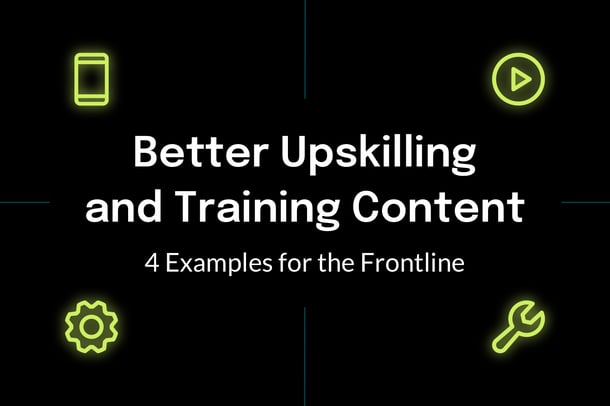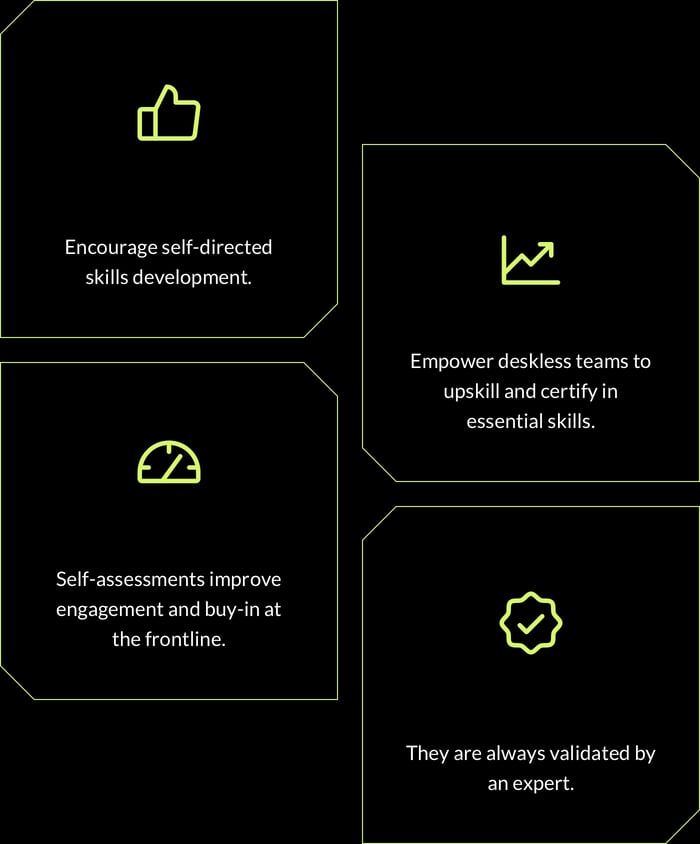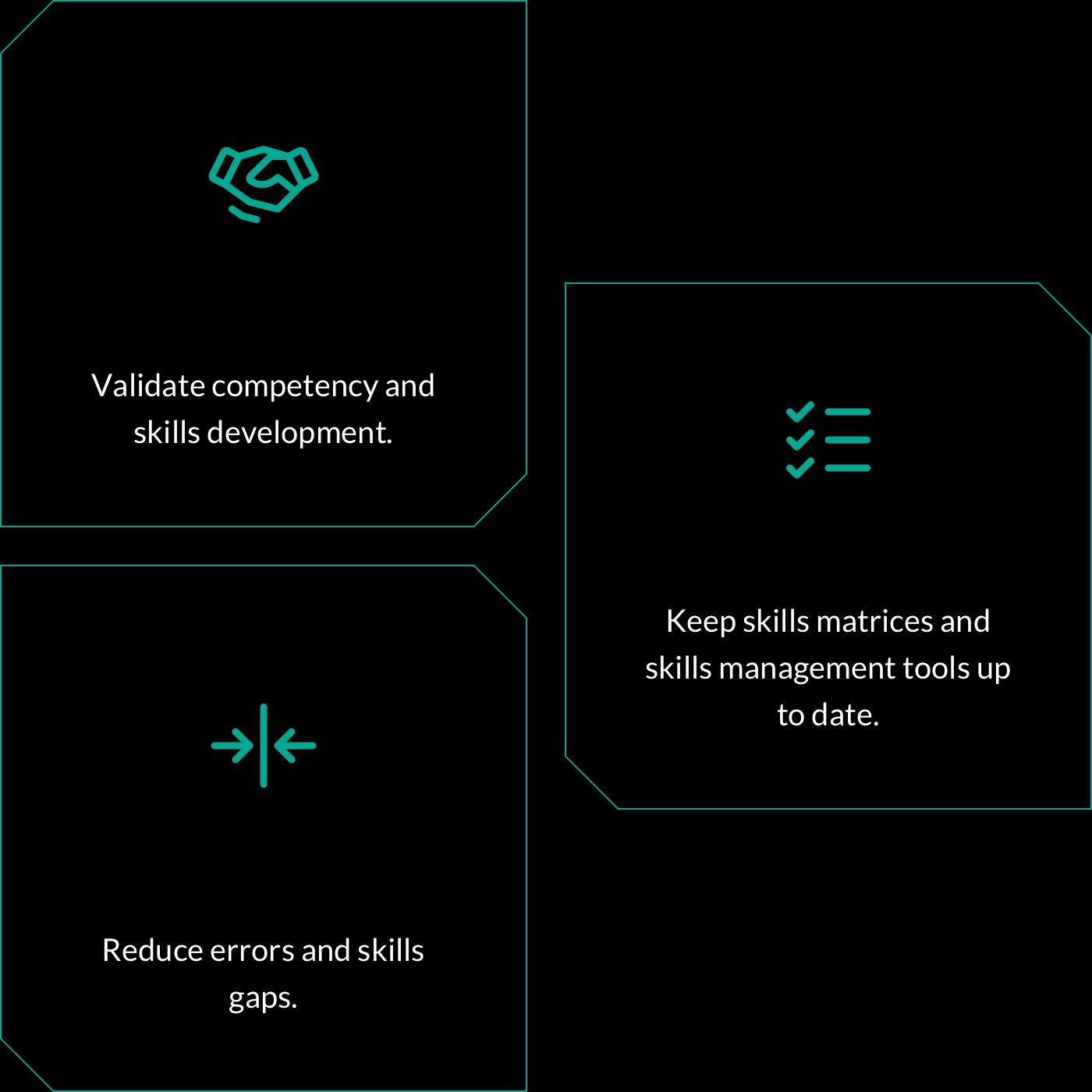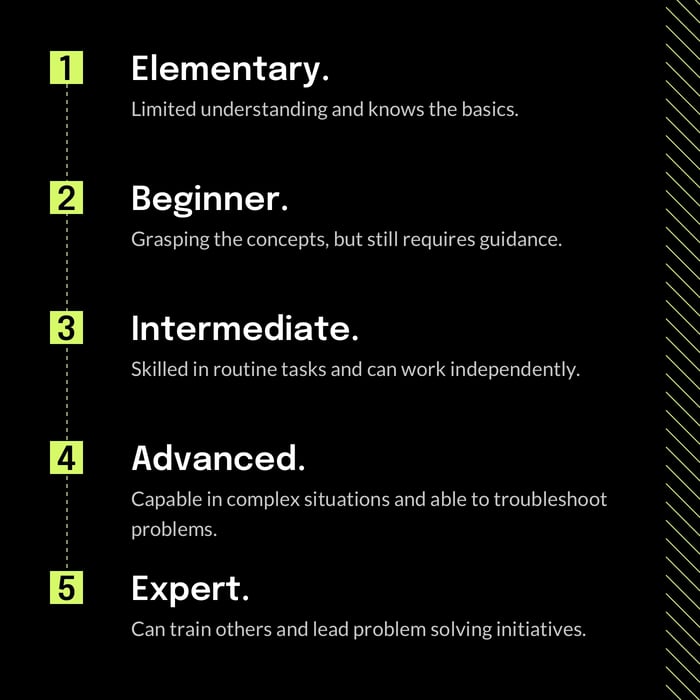

Q&A: How to Use Employee Skills Assessments for Your Deskless Teams
How you can improve your employee skills assessments to close skills gaps and empower frontline teams to drive their own growth.
1. What is an employee skills assessment?
2. Why are skills assessments so important?
3. Who are skills assessments for?
4. How do skills assessments measure competency?
5. What do I do with all this information?
Q1: What is an employee skills assessment?
Employee skills assessment =
"A performance-check that allows an employee to prove their knowledge and competence for a given task."
It’s a pretty simple concept with a broad application in a lot of different industries - it’s clearly essential to be able to confirm that employees are competent.
But how do employee skills assessments impact deskless teams in the manufacturing industry?
In manufacturing, making sure that people are capable of performing complex and potentially dangerous tasks like operating machinery is absolutely crucial. Skills assessments are a way for managers and supervisors to check and certify that their employees have the expertise to perform their jobs safely and accurately, every time.
But skills assessments are also a way to help drive skills development from a bottom-up perspective. In the past, these practices have often been very top-down and neglect to include the frontline as an essential component in their own skills development.
There are a few methods that can be used to understand performance on the shop floor:
- Simple knowledge tests (for level 1 and basic abilities)
- Peer assessments
- Observations (throughout a shift)
- 360 feedback
- Self-assessments
- Skills assessments performed by a manager
We’ll be focusing on the last two types of assessments in this article, due to their ease of integration with a digital skills management system and their ability to populate tools like a dynamic digital skills matrix.
Self-Assessments:
These are performance checks initiated by employees in order to prove and validate their competency on a given task.

Skills Assessments:
These are in-person performance checks performed on the shop floor and validated by a manager or supervisor.

As a whole - Employee skills assessments help to involve and empower the frontline workforce while driving upskilling on the shop floor.
Q2: Why are skills assessments so important?
The simple answer? Proving that your frontline workforce is competent. Seems simple enough, but this basic premise is at the core of improving shift planning, error-reduction, compliance, and onboarding.
1. Improve skills development and validate competence.
Successful skills development depends on having an understanding of your teams and their capabilities. Skills assessments allow you to demonstrate this baseline in a consistent way, while also giving supervisors the ability to validate the results to align with standards and compliance.
2. Help identify and close skills gaps on individual and team level.
Effective skills management and upskilling depends on having accurate information about the abilities of a given employee or team. Once an employee has established their competency, the appropriate learning materials can be delivered to educate and upskill.
When competence is accurately reflected in a skills matrix, supervisors can more effectively plan shifts and flex their teams where they’re needed.
3. Easily test learner understanding on-the-job.
If you have a system that allows you to track and perform skills assessments digitally and on mobile devices, it’s much easier to gauge competencies at the production line and on the shop floor.
4. Provide a framework for engagement and self-efficacy.
Self-assessments are a tool that allows individual employees to certify new skills and expand their career perspective - something that’s essential for them to feel valued and keep them engaged.
Q3: Who are skills assessments for?
For managers and supervisors.
- You’re able to set measurable benchmarks of capabilities that can be directly tied to operations on the factory floor.
- Populate digital skills matrices with accurate data.
- Improve your uptime and product quality with a more competent workforce.
For frontline employees.
- You can prove your own competencies and grow within your role.
- Demonstrate your skills to your supervisors and have them certified within your skills management platform.
- Qualify for any skills-based incentives within your organization.
Q4: How do skills assessments measure competency?
A. Skills Assessments by a manager.
The power of skills assessments lies in your ability to observe your workforce performing their job, and validating this performance against a benchmark. It’s essential to have a set of clearly defined skill levels correlated to an employee’s performance.
Once a supervisor has signed off on an assessment and delivered the relevant feedback, they can be assigned a skill level that will ultimately be used to populate a digital skills matrix.
Examples of common skill levels in manufacturing:

This system allows you to understand competency at a glance - not just to fill skills gaps and flex your teams, but to understand areas for improvement and practice proactive skills development.
B. Self-Assessment.
Self-assessments are performance checks initiated by employees to prove their own competence and check their knowledge about a given subject.
Okay, but why?
These assessments use the same skill levels as above but are driven by the employee, rather than a manager or supervisor. Self-assessments are attached to specific skills and require employees to evaluate their own ability to perform a task.
- Employees can access self-assessments as part of their own skills profile, where they can track their own certifications and abilities as they relate to the jobs they perform on the shop floor.
- They’re used to update competency levels within a skills matrix, once approved by an expert, but self-assessments are also a great moment to intervene with relevant learning content and training materials.
- Self-assessments a tool that allows employees at the frontline to guide their own development, while improving the skills they need to perform their jobs at peak capacity.
It’s worth noting that it’s essential for these self-evaluations to be reviewed and validated by a supervisor. If needed, they can be followed up with more in-depth Skills Assessments or feedback.
Q5: What do I do with all this information?
The ultimate goal of employee skills assessments is to manage and understand the competencies of your frontline workforce. But this data is irrelevant if it’s hard to use or sits in an excel document. When used in combination with a digital tool like a dynamic skills matrix, you’ll be able to track performance and skills gaps with up-to-date and accurate skills profiles.
You can:
- Quickly overview the abilities of your teams.
- Flex the right employees to the right shifts.
- Deliver learning content.
- Drive engagement and buy-in to improve retention
- Validate competencies on-the-job.
- Plan reassessments and trainings proactively.
Want more skills content?
👉 Here are the benefits of a dynamic digital skills matrix.
👉 Here's a great free template to help coordinate employee development.
👉 Here's a breakdown of reskilling vs. upskilling (and the importance of each) at the frontline.
Author
Revisions
It's time to simplify frontline training
Work instructions, checklists, and skills management - all in SwipeGuide
- Cut training time by 50%
- SOC I and II compliant
Get to know us
SCHEDULE YOUR DEMOResources
-
1
How to empower your frontline with better instructional design. -
2
How to gain the edge in Industry 4.0 with smart manufacturing practices. -
3
How to make excellent digital work instructions. -
4
How to deliver continuous improvement at the frontline with Lean principles. -
5
How to capture, share, and improve expert knowledge with digital SOPs.


